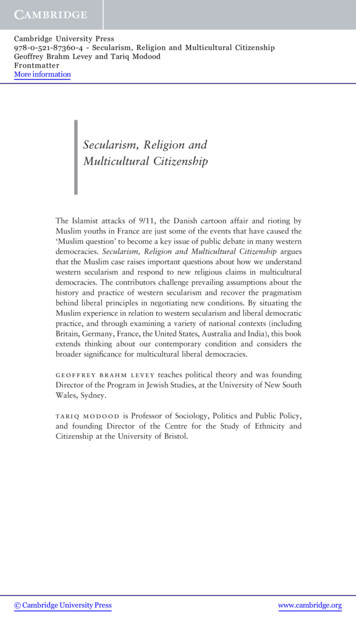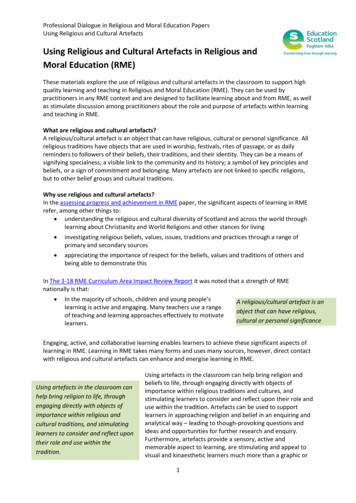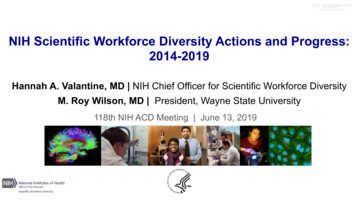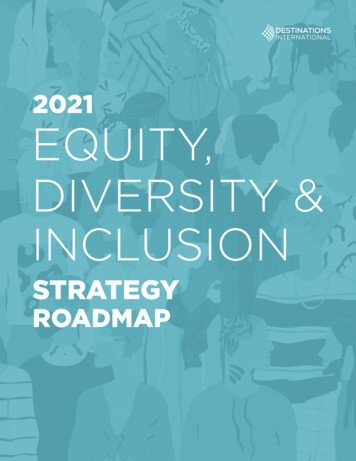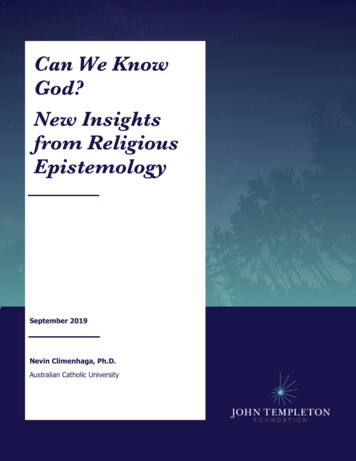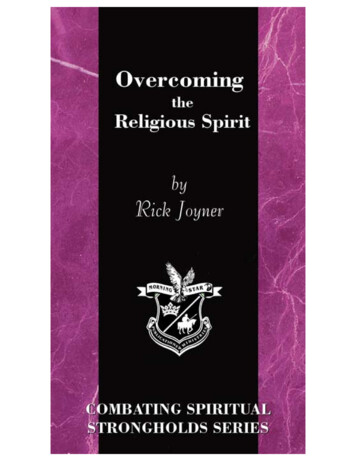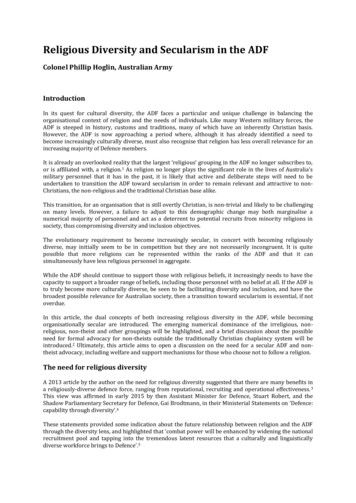
Transcription
Religious Diversity and Secularism in the ADFColonel Phillip Hoglin, Australian ArmyIntroductionIn its quest for cultural diversity, the ADF faces a particular and unique challenge in balancing theorganisational context of religion and the needs of individuals. Like many Western military forces, theADF is steeped in history, customs and traditions, many of which have an inherently Christian basis.However, the ADF is now approaching a period where, although it has already identified a need tobecome increasingly culturally diverse, must also recognise that religion has less overall relevance for anincreasing majority of Defence members.It is already an overlooked reality that the largest ‘religious’ grouping in the ADF no longer subscribes to,or is affiliated with, a religion.1 As religion no longer plays the significant role in the lives of Australia’smilitary personnel that it has in the past, it is likely that active and deliberate steps will need to beundertaken to transition the ADF toward secularism in order to remain relevant and attractive to nonChristians, the non-religious and the traditional Christian base alike.This transition, for an organisation that is still overtly Christian, is non-trivial and likely to be challengingon many levels. However, a failure to adjust to this demographic change may both marginalise anumerical majority of personnel and act as a deterrent to potential recruits from minority religions insociety, thus compromising diversity and inclusion objectives.The evolutionary requirement to become increasingly secular, in concert with becoming religiouslydiverse, may initially seem to be in competition but they are not necessarily incongruent. It is quitepossible that more religions can be represented within the ranks of the ADF and that it cansimultaneously have less religious personnel in aggregate.While the ADF should continue to support those with religious beliefs, it increasingly needs to have thecapacity to support a broader range of beliefs, including those personnel with no belief at all. If the ADF isto truly become more culturally diverse, be seen to be facilitating diversity and inclusion, and have thebroadest possible relevance for Australian society, then a transition toward secularism is essential, if notoverdue.In this article, the dual concepts of both increasing religious diversity in the ADF, while becomingorganisationally secular are introduced. The emerging numerical dominance of the irreligious, nonreligious, non-theist and other groupings will be highlighted, and a brief discussion about the possibleneed for formal advocacy for non-theists outside the traditionally Christian chaplaincy system will beintroduced.2 Ultimately, this article aims to open a discussion on the need for a secular ADF and nontheist advocacy, including welfare and support mechanisms for those who choose not to follow a religion.The need for religious diversityA 2013 article by the author on the need for religious diversity suggested that there are many benefits ina religiously-diverse defence force, ranging from reputational, recruiting and operational effectiveness. 3This view was affirmed in early 2015 by then Assistant Minister for Defence, Stuart Robert, and theShadow Parliamentary Secretary for Defence, Gai Brodtmann, in their Ministerial Statements on ‘Defence:capability through diversity’.4These statements provided some indication about the future relationship between religion and the ADFthrough the diversity lens, and highlighted that ‘combat power will be enhanced by widening the nationalrecruitment pool and tapping into the tremendous latent resources that a culturally and linguisticallydiverse workforce brings to Defence’.5
However, although the need for religious diversity seems relatively intuitive, the numerical reduction inreligiosity has not received the attention that might seem obvious. Furthermore, the possibility thatsociety will demand secularism in its public institutions has not been considered by an ADF thatcontinues to maintain a relatively high-level (and dominantly Christian) Religious Advisory Committee tothe Services, and a Principal Chaplains Committee.The risk to the ADF is that it will continue to be perceived as predominantly conservative and Christian,when the reality is already different. Hence, while there are strategic benefits to becoming a morereligiously-diverse defence force, there are also benefits to becoming organisationally secular, and a movetoward secularism should occur in tandem with increases in religious diversity.Changing religious landscapeIn the space of just one generation, the ADF has gone from an overwhelmingly Christian to anincreasingly-irreligious organisation. Personnel indicating ‘no religion’ on census and human resourcedata are the largest single group in the ADF and, within just a few more years, this group will benumerically larger than all religious groupings combined.6Notably atheism, which is still a relatively small group, is the single fastest growing in the ADF andrecently entered the top ten ADF ‘religious belief’ groupings (albeit with no religious belief). Significantly,if it were classified as a ‘religion’, atheism would already have a case for advocacy or representation onthe Religious Advisory Committee, in accordance with Defence Instructions and the associatedmemorandum of 020112012201320142015No religionFigure 1: Religiosity of ADF permanent force members 2003-2015Figure 1 shows the extent and pace of the demographic change in religious affiliation in the permanentADF since 2003. Just 10 years ago, over two-thirds of all personnel nominated Christianity as theirreligious affiliation. In 2015, this proportion had reduced to just over 52 per cent, with personnel notidentifying a religious affiliation accounting for over 47 per cent, and other non-Christian religionsaccounting for the remaining 1 per cent. Based on current trends, Christianity will account for less thanhalf of the population by the end of 2016, and those with no affiliation will comprise the numericalmajority in the following year.
This change may be even more rapid in junior officers and enlisted ranks. Figure 2 shows that currently62 per cent of all Privates (E) and 64 per cent of all Officer Cadets and Midshipmen are not affiliated witha religion.8 Based on these figures, in another 25 years, when these personnel filter into the seniorenlisted and officer ranks, almost two-thirds of the ADF will not be affiliated with any religion. Assumingthe ADF is successful in attracting personnel from a broader range of society, including smaller religiousgroups, it is likely that personnel with Christian affiliation will account for less than 30 per cent of theADF by tion of ADF permanent force membersThis changing landscape is in very stark contrast to previous generations, where religious affiliation wasstable: one was either of a Catholic, Anglican or Protestant denomination. The near-binary nature ofreligious affiliation in previous generations is hinted in Figure 2, which indicates that over 87 per cent ofthe ADF’s current star-ranked officers (typically recruited in the early 1980s or earlier) are affiliated withChristianity, as are 80 per cent of WO1s (E). This difference between the junior and senior ranks issignificant and demonstrates the rapid and consistent change in religiosity in the ADF since the 1980s.No religionFigure 2: Religiosity of ADF permanent force members by rank as at July 2015The emerging demographic, decreasing religiosity and stated desire to be more diverse and inclusiveshould encourage Defence to question the traditional hierarchical level and status that is currentlyafforded to religion in the ADF. In order to become visibly secular, religion will need to be transposedfrom its current and unique status within the ADF to the same level at which other dimensions ofdiversity, such as gender, LGBTI (lesbian, gay, bisexual, transgender and intersex), and indigenous affairsare considered.As is already the case with these other dimensions, religion in the ADF may need to be subtly re-framed tospecifically provide support to those members for whom it is necessary, rather than the current modelthat presumes an overwhelmingly religious population. This would require consideration of religion as adimension in the culture and diversity spectrum, rather than its current stand-alone position in theworkforce dialogue.The growing strength of non-theistsWhile religiosity itself has been declining in the ADF, declared atheism has been the fastest growing‘religious’ grouping in the ADF, increasing in strength from just 89 in 2003 to over 470 in mid-2015. This
makes them the eighth largest religious grouping and roughly the same strength as Buddhists, Hindus,Muslims and Sikhs combined. Additionally, agnostics have tripled in strength over the same period andare just outside the largest ten denominations. Some of this may be due to a greater societal awareness ofatheism and non-theism; however, the growth also likely reflects a genuine shift in belief systems inAustralia and in the ADF. Table 1 shows the change in the proportion of each religious affiliation between2003 and 2015.Table 1: Comparison of 20 largest religious groupings/denominationsin the ADF, between 2003 and omination%1No religion30.69No religion45.382Christian - Catholic25.91Christian - Catholic21.693Christian - Anglican25.06Christian - Anglican15.484Christian - Uniting5.44Christian - Other Protestant6.795Christian - Other Protestant2.55Christian - Uniting2.886Christian Presbyterian/Reformed2.53Christian Presbyterian/Reformed1.357Christian - Other1.83Christian - Lutheran0.878Christian - Baptist1.35Atheist0.839Christian - Lutheran1.31Christian - Other0.8010Christian - Salvation Army0.46Christian - Baptist0.7811Christian - Eastern Orthodox0.40Christian - Eastern Orthodox0.4312Christian - Pentecostal0.40Agnostic0.3513Christian - Churches of Christ0.38Christian - an - Latter Day Saints0.17Hindu0.2616Atheist0.17Christian - Salvation Army0.2517Christian - Seventh DayAdventist0.10Christian - Churches of stian - Latter Day Saints0.1620Judaism0.06Christian - Seventh DayAdventist0.11Other0.68Other0.57It is notable that atheists and agnostics often make a very deliberate decision to designate and selfdeclare their religious views, rather than the more passive default of ‘no religion’. This deliberate and
personal decision has potential ramifications in the diversity sphere because it is likely that some atheistsare not only irreligious but passionate about the removal of religion from public institutions.Such personnel, although likely to be small in number in the ADF, may be vocal and likely to campaign fororganisational secularism, a possibility that Defence’s leadership may need to consider in the future andfor which it is currently ill-prepared. It is likely that this group of non-theists will, in the passage of time,request equality of influence, consideration and advocacy from Defence’s leadership.Non-theist advocacy and the Religious Advisory CommitteeThis article has suggested, based on numerical strength and supported by Figures 1 and 2, and Table 1,that religious faith-based support services will not be required to the same extent they have in previousgenerations. However, this does not suggest that they are not required at all. The ADF, as with society, willcontinue to have a large number of individuals who are dedicated to their religious beliefs and whorequire advocacy and support in pursuit of their faith.However, Christian denominations are not the only groups where such support and advocacy will berequired and, while there is an increasing need for the involvement of leaders from non-Christian faiths inDefence, it is also likely that non-religious groups will require advocacy and representation in their ownright as they become larger, more visible and more clearly defined.While non-theists may not necessarily require specific advocacy support in the same way that religiouspersonnel do, the current lack of advocacy, support networks and discussion groups run the risk that thislarge and emerging demographic will be under-represented in relevant forums. Eventually, and as soonas late 2016, the Religious Advisory Committee will not represent the majority of Defence personnel or itsfastest growing ‘religious’ groupings.Without the inclusion of atheists, irreligious and non-theists in the diversity debate, there will be acontinuation of the disproportionate influence of religion on military affairs at a time when strategicsecularism is a more desirable objective for diversity and inclusion. However, to achieve well-balancedadvocacy for the variety of religious affiliations likely to be represented in the ADF of the future, there willbe a need to actively and deliberately create advocacy mechanisms within the diversity and inclusiondialogue.A diverse but secular ADF – the benefits of secularismIn the main, Australian Government departments are secular, and religion has almost no perceived oractual influence on the organisation.10 Defence is one of very few State, Territory and Federal Governmentdepartments that maintains a large number of ongoing positions for chaplains, and the only departmentthat holds both high-level (one-star/SES-band) and public office holder positions for the provision ofstrategic religious advice ‘to provide the link between the ADF and the governing bodies of Church andDenominational Groups’.11 Whether perception or otherwise, this status of religious influence means thatthe ADF is functionally non-secular and that religion, especially Christianity, is ingrained and deeplyimbedded in its organisational structure at a relatively high level.Notwithstanding the current status of religion in the ADF, it is possible to have both a strong advocacystructure, and still become a secular organisation. Such an approach would require several antecedents.Firstly, broader representation of religious minorities and non-theists would be required either as part ofor parallel to the Religious Advisory Committee, with an equivalency of status.12Secondly, the hierarchical influence of the Religious Advisory Committee and Principal ChaplainsCommittee would need to be placed at the same level as that of other diversity advocates, committees andforums. Once achieved, there are many significant benefits for the ADF, without detracting from orremoving any of the support offered to personnel currently provided by the ADF’s chaplains, as follows. Perception of the ADF on operations. It is likely that a largely Christian military operating in anenvironment where the local population, allies or adversary are not Christian, does the ADF fewfavours. At one extreme, it provides an adversary with another point of difference and a theological
reason to maintain a conflict or target ADF personnel. To an equal extent, it can present social,cultural and religious barriers with the local population. While being secular may not necessarilymitigate this perception, being ‘less Christian’ might. Perception of the ADF at home. The ADF still has a largely white, Anglo-Saxon and maledominated population.13 To some extent, and in a different era, this type of population may havereflected society’s expectations of its military. But this is no longer the case and the ADF cannotafford to be so significantly and demographically disconnected from the population it defends if itwishes to remain a well-regarded, modern and representative military. A detachment from religionand visible appearance as a secular public organisation would provide the ADF with sociallegitimacy and would become increasingly important for the reputation of the ADF as the nation’spopulation changes. Enhancement of recruiting. A visibly non-secular organisation is likely to present a barrier toentry to some potential recruits, including those from non-Christian backgrounds and non-theists.While non-theists may be less deterred from entry, it is reasonable to expect that a candidate whois Hindu, Sikh, Buddhist, Muslim or of another non-Christian religion would not view a visiblyChristian organisation positively or feel that their needs could be supported within thatorganisation. Removal of this perception may be sufficient to facilitate greater numbers of recruitswho may also be from more culturally-diverse backgrounds. Organisational inclusivity and acceptance. Although there have been some recent advances, theADF overwhelmingly remains a binary organisation where its members are Christian or not. Thereis very little recognition of the diversity of views and beliefs that already exist and almost noorganisational attempt to understand this diversity. While the 2012 Guide to Religion and Belief inthe Australian Defence Force mentions non-religion/non-belief (at the very last section of thedocument), theological beliefs are not equally catered for by Defence. When the ADF is visibly andtruly secular, all its members would be able to feel and observe that their beliefs are treatedequally and considered in the diversity dialogue. Consolidation of counselling services. A range of Defence personnel, including chaplains,currently provide counselling services for serving ADF personnel. The long-held view thatchaplains can adequately support the counselling needs of the widest range of beliefs in the ADF’spopulation, including non-Christian beliefs, is not as easily supported as it once might have been.14While some irreligious and non-Christian individuals may feel comfortable seeking welfare supportfrom a Christian chaplain, this is increasingly unlikely to be the case and will result in a demand fornon-theist counsellors, psychologists or chaplains from minority religions. Secularism provides anopportunity to consolidate and coordinate the provision of counselling services so that it can betargeted towards the specific needs of the population rather than trying to adapt a non-secularmodel to a diverse population. Development of a non-theist community. Although not all non-theists would necessarily wish tobe involved with an associated community, recognition of secularism and the diverse views ofmembers would permit and facilitate the development of support networks and forums for thosewho do. The theist community already has many such communities, including the MilitaryChristian Fellowship of Australia, Focus Military Ministry, The Australian Navigators, Solid RockMinistries, Red Shield Defence Services and Everyman’s Welfare Services, hence there is scope foractive encouragement of the creation of other groups to support the broad range of beliefs thatalready exist.Pathway to secularismIn principle, a conceptual pathway to a secular ADF is not difficult to achieve. However, secularism wouldentail a reassessment of over a century of customs and traditions which has resulted in Christianity beingthreaded through many seemingly routine activities, ceremonies and symbols. Nonetheless, while theremay be no need to remove some customs and traditions, the current existence of Christian influence in
the ADF does not provide an adequate reason for their continuance where they inhibit an aspiration ofsecularism.There are several approaches that might facilitate an evolution toward secularism, ranging from adramatic removal of religion and its references from all aspects of military life, to a more passiveapproach that accommodates religious diversity in all its guises. While the latter is more likely to succeed,both options would require the ADF to carefully reconsider the existing need and hierarchical position ofthe Religious Advisory Committee and the role of the Principal Chaplains Committee. Initially, the ADFwould also need to critically review the current involvement of religion, especially Christianity, in thetraditions of the ADF, including activities such as commencement ceremonies, graduations, formaldinners, memorial services, counselling services, external affiliations and general symbology.Once such a review is completed, the ADF could then consider each activity separately with a view toenhancing those where more religious diversity is achievable, retaining others where the religiousconnotation has been lost over time, or removing those that are no longer required or could be viewed asinsensitive. For example, counselling services may need to become broader, ceremonies may need tobecome multi-religious, and other activities may need to be discontinued altogether. Importantly, anyactivities where one religion is over-represented or dominates should be reassessed with particular focuson the perception of that activity and the relevance of religion in that activity.The method that the ADF uses to achieve secularism will require, like other aspects of diversity, adeliberate, sensitive and well-thought-out strategy. In many quarters of society, the observance ofreligion remains a highly-contentions and emotionally-charged issue, including the freedom to exerciseno religion. However, as exhibited by its gender and LGBTI strategies, which had their own sources ofinternal and external change resistance, the ADF is wholly capable of transitioning to a secularorganisation should it choose to do so.ConclusionThe ADF is on a journey of increasing its diversity across many dimensions but, despite significantdemographic changes in religious affiliation that have already occurred, religiosity and secularism remainmarginal and elusive topics. It is a reality that religion no longer plays the same role in the everyday livesof a large proportion of servicemen and -women that it once did. Yet organisationally, Christianityremains prominent in many of Defence’s current-day activities. As the predicted number of non-religiouspersonnel reaches and then exceeds a numerical majority in the next two years, Defence shouldreconsider the organisational position that religion currently holds.Reviewing the role of religion will not be easy for the ADF, not least because of its intricate associationwith many customs and traditions. However, there are good reasons to pursue a secular military. Asecular ADF would remove many cultural barriers to entry, encourage a more balanced perception of itspersonnel, and position it as a truly impartial organisation that is able to adapt to a wide range ofoperational environments free from religious constraints.In reflecting the broader range of beliefs that exist in Australian society, it will become increasinglyimportant that the ADF is perceived as an institution able to fulfil both the needs of its members and thesecular expectations of the nation. If this is not achieved, the ADF will risk perpetuating an image thatisolates it from both its own membership and the Australian population.Despite the changing religiosity, the need to become secular does not reduce the significant role thatreligion has, and will continue to have, in the lives of many Defence personnel. Even though their strengthis declining, the ADF will still need to provide support to those wishing to pursue their religious beliefs;however, it will need to do so in a renewed context through the lens of cultural diversity.To achieve this, religious advocacy committees will need to be positioned at the same organisational andinfluence level as other diversity committees and forums. Simultaneously, the ADF will need to increaseits ability to support non-Christian religions and non-theists in the same way that it currently providessupport to its Christian personnel.
For the same reasons that Defence wishes to be perceived as an inclusive employer of women, IndigenousAustralians and members of the LGBTI community, it should also aspire to appeal to a broad range ofrecruits from diverse cultures and religions. In its journey to achieve this, the ADF will need to takemeasures to become visibly and functionally secular far beyond the application of its associated rhetoric.This will provide some challenges for the ADF and may need some of its long-held views, customs andtraditions to be examined closely through the context of diversity and inclusion. Such challenges havebeen successfully faced and overcome by Defence before, and it can be done again.Colonel Phillip Hoglin graduated from RMC in 1994, having completed a Bachelor of Science(Honours) majoring in statistics. In 2004, he completed a Master of Science in Managementthrough the US Postgraduate School and, in 2012, a Master of Philosophy through theUniversity of New South Wales. He has had several appointments in workforce analysis, policy,strategy and management roles, and is currently the Director of Military People Policy inDefence People Group.Notes1In the context of cultural diversity, this article considers religion to be intricately linked to culture.2There are many emerging terms for non-religious individuals. This article uses them interchangeably withmuch the same meaning but it is recognised that in literature some distinctions are often made. These termsinclude but are not limited to atheism, agnosticism, apatheism, humanism, non-theism, rationalism, antitheism and others.3P. Hoglin, ‘Religious diversity in the Australian Army: the next diversity frontier?’, Australian Army Journal,Vol. X, No. 3, 2013, pp. 79-96, available at http://www.army.gov.au/ 13/AAJ 2013 3.pdf accessed 8 February 2016.4Government of Australia, ‘Parliamentary debates: House of Representatives Ministerial Statements, Defence:capability through diversity’, 2 March 2015, pp. 1643-1649, available at /display.w3p;query 79-f44e8a7ac864%2F0152%22 accessed 8 September 2015.5Government of Australia, Parliamentary debates, p. 1644.6Data from the 2011 Defence Census (internal to Defence) indicated that 37 per cent of permanent forceDefence personnel reported no religious affiliation (2011 PMKeyS data indicated 39 per cent). 2015 censusdata was not available for this article at the time of publication.7Department of Defence, Defence Instructions (General) Personnel 26-1: Religious Advisory Committee to theServices and Principal Chaplains’ Committees, Department of Defence: Canberra (internal to Defence), statesthat a ‘denomination/faith-group with more than 250 self-declared adherents in the permanent forces maysubsequently approach the Minister for Defence for representation through the Religious AdvisoryCommittee’. This requirement has been removed from the recently-released Defence Chaplaincy Manual.8Between 2011 and 2015 (inclusive), an average of almost 5300 permanent force members were recruitedeach year, 63.9 per cent of whom did not indicate a religious affiliation. In 2015 alone, 70.0 per cent did notindicate a religion.9The ADF should not necessarily be surprised by this rapid change, as it is not unique to the ADF. Although therate of change is somewhat faster, the same trend exists more broadly in the Australian population, wherealmost 40 per cent of young Australians aged between 20 and 29 either had no religion or their religion wasnot stated on the 2011 census.
10Some police and emergency service departments continue to have a small number of chaplains, although theiremployment status and funding within the organisation varies from that of an employee to an honoraryappointment, to a volunteer association in times of higher demand. Some State and Territory schools alsoutilise the National School Chaplaincy Programme. Even when used, chaplains provide targeted religioussupport to the membership. There is no equivalent to the high-level religious advocacy structure offered byReligious Advisory Committee and the Principal Chaplains Committee in Defence.11Department of Defence, Memorandum of Arrangements Between the Commonwealth of Australia Representedby the Chief of the Defence Force and Heads of Churches Representatives (Religious Advisory Committee to theServices), Department of Defence: Canberra, 2 December 2008 (internal to Defence). The responsibilities andauthority of the Religious Advisory Committee, as outlined in the memorandum, is extensive and includesadvice, policy development, selection and recruitment and other matters usually associated with commandand administration.12In creating an advocacy for non-theists, it is acknowledged that the notion that a ‘majority’ demographicwould need its own representation in a diversity context may seem a little inconsistent with other diverseworkforce segments that are clearly under-represented in the ADF. However, non-theists have historicallyconstituted a minority, and retain many of the associated characteristics.13Furthermore, chaplaincy itself remains remarkably homogeneous. As at July 15, 95 per cent of all permanentchaplains were male, their average age was 51 (just 10 per cent are under the age of 40), over 83 per cent aremarried, 83 per cent were born in Australia or the UK and only 2 have self-identified as an Aboriginal orTorres Strait Islander. These figures make chaplains among the least diverse employment category in ADF.14To a regular serviceman or -woman, chaplaincy and religion are inextricably linked. Chaplains dress accordingto their faith, are often identifiable by religion in their accoutrements, have offices adorned with religiousartefacts, coffee tables and desks have bibles, and hymn books reside on bookshelves. This reality means thatthe provision of welfare support by chaplains c
Religion/denomination % Religion/denomination % 1 No religion 30.69 No religion 45.38 2 Christian - Catholic 25.91 Christian - Catholic 21.69 3 Christian - Anglican 25.06 Christian - Anglican 15.48 . It is notable that atheists and agnostics often make a very deliberate decision to designate and self- declare their religious views, rather .
